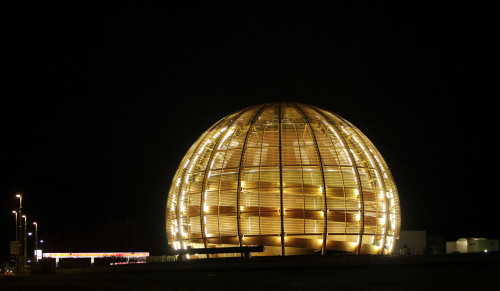GENEVA (AP) -- The chances have risen that Einstein was wrong about a fundamental law of the universe.
Scientists at the world's biggest physics lab said Friday they have ruled out one possible error that could have distorted their startling measurements that appeared to show particles traveling faster than light.
Many physicists reacted with skepticism in September when measurements by French and Italian researchers seemed to show subatomic neutrino particles breaking what Nobel Prize-winning physicist Albert Einstein considered the ultimate speed barrier.

The European Organization for Nuclear Research said more precise testing has now confirmed the accuracy of at least one part of the experiment.
``One key test was to repeat the measurement with very short beam pulses,'' the Geneva-based organization, known by its French acronym CERN, said in a statement.
The test allowed scientists to check if the starting time for the neutrinos was being measured correctly before they were fired 454 miles (730 kilometers) underground from Geneva to a lab in Italy.
The results matched those from the previous test, ``ruling out one potential source of systematic error,'' said CERN.
Still, scientists stressed that only independent measurements by labs elsewhere would allow them to declare that the results of their experiment were a genuine finding.
``A measurement so delicate and carrying a profound implication on physics requires an extraordinary level of scrutiny,'' said Fernando Ferroni, president of Italian Institute for Nuclear Physics. ``The positive outcome of the test makes us more confident in the result, although a final word can only be said by analogous measurements performed elsewhere in the world.''
According to Einstein's 1905 special theory of relativity, nothing is meant to be able to go faster than the speed of light _ 186,282 miles per second (299,792 kilometers per second).
But the researchers said in September that their neutrinos traveled the distance from Geneva to Gran Sasso 60 nanoseconds faster, when the margin of error in their experiment allowed for just 10 nanoseconds. A nanosecond is one-billionth of a second.
<한글기사>
"빛보다 빠른 입자, 2차 실험서도 확인"
최근 빛의 속도보다 빠른 입자를 발견했다는 실험 결과를 발표 한 유럽입자물리연구소(CERN)의 과학자들이 2차 실험에서도 1차 실험과 같은 결과를 확인했다고 워싱턴포스트(WP)가 18일 보도했다.
1차 실험에 참여했던 과학자중 한명인 이탈리아 핵물리학연구소의 페르난도 페 로니 소장은 17일(현지시간) 성명을 통해 "2차 실험에서 긍정적인 결과가 나와 (빛 의 속도보다 더 빠른 입자가 있다는 기존) 결과를 더욱 확신할 수 있게 됐다"고 밝 혔다.
그러나 페로니 소장은 2차 실험에서 "실험 결과의 일관성에 대한 중요한 시험이 이뤄졌다"면서도 "최종 결론은 세계 다른 곳에서 유사한 측정이 이뤄져야 내릴 수 있다"고 강조했다.
이는 실험 결과를 확인하기 위해서는 추가적인 실험이 필요하다는 것을 의미한 다.
지난 9월 CERN은 3년간 스위스 제네바의 실험실에서 732㎞ 떨어진 이탈리아 그 란 사소의 실험실까지 땅속으로 중성미자(뉴트리노)를 보내는 실험을 진행한 결과 뉴트리노들이 빛의 속도보다 60나노초(0.00000006초) 빨리 목적지에 도착한다는 사 실을 발견했다고 발표했다.
그러나 이에 대해 많은 물리학자들은 측정상의 오류로 인한 것이 아니겠느냐며 회의적인 반응을 보여왔다.
일각에서는 CERN에서 만들어진 중성미자(뉴트리노)가 세밀하게 측정되기에는 너 무 넓게 퍼졌다고 지적하기도 했다.
이에 2차 실험에서는 제네바 실험실에서 이탈리아의 실험실로 보내는 뉴트리노 들을 좀더 촘촘하게 했다.
프랑스의 국립과학연구센터(CNRS) 책임자인 쟈크 마티노는 실험이 끝난 것은 아 니며, 연구진이 실험 구간 사이에 섬유를 놓는 방안을 포함해 추가 대조 검토 방법 에 대해 논의하고 있다고 밝혔다.





![[KH Explains] No more 'Michael' at Kakao Games](http://res.heraldm.com/phpwas/restmb_idxmake.php?idx=644&simg=/content/image/2024/04/28/20240428050183_0.jpg&u=20240428180321)













